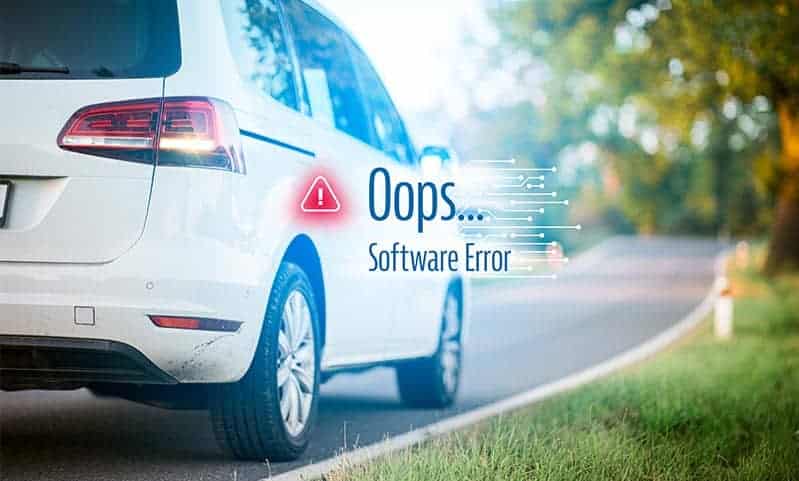Driverless cars are here, at least to an extent. Most people operate Level 1 or Level 2 autonomous vehicles.
Level 1 cars and trucks have some features, such as anti-lock brakes and blind spot sensors, which help them operate their vehicles.
Level 2 cars and trucks, like a GM Cruise, have more advanced driver-assist features which allow motorists to multitask behind the wheel.
Level 5 driverless cars, which are completely automated vehicles which have no steering wheels, are still several decades away.
Generally, when automotive software fails, the driver is legally responsible for any resulting damages. Sometimes, a third party, such as a manufacturer, could be at least partially responsible. More on that below.
As cars and trucks become increasingly complex, car crash damages claims become increasingly complex as well.
These intricacies underscore the need for a good New York personal injury attorney. Only an experienced lawyer can properly review your claim and quickly identify all possible claims and defenses.
Additionally, only an experienced attorney has the resources to collect solid evidence, and the skills to put these pieces of evidence together in the right way.
Duty of Care
A negligence claim begins with the appropriate duty of care. The basic idea for the duty of care comes from the Golden Rule (do unto others as you would have them do unto you).
The specific nature of the duty of care varies in different situations.
Operators
Most drivers in the Empire State, whether they are commercial or noncommercial operators, have a duty of reasonable care.
They must drive defensively, obey the rules of the road, and avoid accidents if possible.
This duty of care is usually fixed. A teenager who has been driving for three hours has the same duty of care as an adult who has been driving for three decades.
Moreover, the type of vehicle does not affect the duty of care. Motion sensors do not eliminate the responsibility to look before turning or changing lanes.
If drivers breach the duty of care and cause crashes, they could be legally responsible for damages.
These damages normally include compensation for economic losses, such as medical bills, and noneconomic losses, such as pain and suffering.
Manufacturers
Selfish drivers who put their own convenience before the safety of others could injure several people at once.
Selfish companies which put profits before people could injure several thousand people at once. Therefore, the level of legal responsibility is higher.
Automobile manufacturers, including companies which make driver assist gadgets, are strictly liable if their defective products cause injury.
This liability includes not only compensatory damages for economic and noneconomic losses.
These companies are usually also liable for punitive damages. These additional damages punish the company and deter future wrongdoing.
Jurors may award punitive damages if there is clear and convincing evidence that the company intentionally disregarded a known risk.
Breach of Duty
Drivers or companies breach their duty of care if their conduct falls below the minimum standard.
Not every driver’s error or manufacturer’s mistake is a breach of duty. Distracted driving is a good example.
Technically, distracted driving happens when drivers take their eyes off the road (visual distraction), a hand off the wheel (manual distraction), or their minds off driving (cognitive distraction).
These categories include things like changing the radio station or looking out the window. However, most jurors do not consider such behavior a breach of care.
Activities like continual use of a hands-free phone or arguing with a passenger are much different. Most jurors would agree that these people were dangerously distracted.
Operators
In New York, driver negligence could involve the ordinary negligence doctrine or the negligence per se rule. Speeding is a good example of the difference.
The posted speed limit in New York is presumptively a reasonable speed.
Tortfeasors (negligent drivers) who break this law and cause crashes could be liable for damages as a matter of law, pursuant to the negligence per se rule.
Sometimes, a driver could be operating below the posted limit and still be speeding.
For example, drivers have a duty to slow down when visibility is reduced or the road is wet. If drivers fail to do so, and that failure causes a crash, the driver could be responsible for damages.
Manufacturers
An automotive safety software failure could be a design defect or a manufacturing defect. Strict liability applies in both instances.
Some sensors are either too sensitive or not sensitive enough.
If they are too sensitive and go off constantly, drivers tend to ignore the warnings. If they are not sensitive enough, drivers might not be aware of the danger.
In other cases of automotive software failure, manufacturers use cheap parts or components which compromise the device’s effectiveness.
Procedurally, most car crash claims name the driver as a defendant.
If the driver feels that the manufacturer’s failure contributed to the crash, the driver could file what is called an impleader action.
But that dispute is between the driver and manufacturer.
Either drivers or manufacturers could be liable for automotive software failure accidents.
For a free consultation with an experienced personal injury attorney in New York, contact Napoli Shkolnik PLLC. You have a limited amount of time to act.
